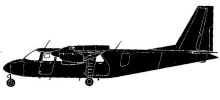
ASN Wikibase Occurrence # 320650
| Date: | Sunday 3 November 2013 |
| Time: | 19:08 |
| Type: |  Pilatus Britten-Norman BN-2B-21 Islander |
| Owner/operator: | Channel Islands Air Search - CIAS |
| Registration: | G-CIAS |
| MSN: | 2162 |
| Year of manufacture: | 1982 |
| Engine model: | Lycoming IO-540-K1B5 |
| Fatalities: | Fatalities: 0 / Occupants: 5 |
| Aircraft damage: | Substantial, written off |
| Category: | Accident |
| Location: | Devil's Hole, Saint Mary, Jersey -
 United Kingdom United Kingdom
|
| Phase: | En route |
| Nature: | Survey |
| Departure airport: | Guernsey Airport, Channel Islands (GCI/EGJB) |
| Guernsey Airport, Channel Islands (GCI/EGJB) | |
| Investigating agency: | AAIB |
| Confidence Rating: |
At approximately 18:20 hrs on 3 November 2013, the Channel Islands Air Search organisation was alerted to carry out a search for two fishermen who were in difficulties near Les Écréhous, a group of rocks north-east of Jersey, Channel Islands. The pilot, accompanied by the search director, and three observers, gathered at the aircraft's base at Guernsey Airport, and made preparations for flight. There was no moon and the Channel Islands were affected by poor weather, with strong southerly winds, low cloud, and poor visibility.
The aircraft took off at 18:47 hrs and, taking account of the cloud base and visibility, the pilot levelled the aircraft at approximately 700 ft amsl on track towards the search area.
When the aircraft was approximately six miles north of Jersey Airport, the right engine rpm began to vary, repeatedly reducing and then increasing. The observer seated to the right of the pilot, observed the fuel pressure fluctuating but this was not noticed by the pilot. The pilot selected the alternate intake air but the engine then stopped. The pilot feathered the propeller and then completed the engine shutdown checks. Following a brief conversation with the search director, the pilot turned the aircraft towards Jersey Airport and declared a MAYDAY to ATC, while the search director made a similar call on the maritime frequency. The pilot applied full power on the left engine and put the aircraft into a climb.
The aircraft had climbed to approximately 1,100 ft amsl when the left engine rpm began to fluctuate before the engine ceased to produce power. The pilot informed ATC that the aircraft was "going down" and the search crew stowed their equipment. No attempt was made to re-start either engine.
An offshore lifeboat operating nearby changed its course to be in attendance should the aircraft ditch. As the aircraft descended, the radio altimeter issued an alert prompting the pilot to switch on the landing lights and instruct the crew to brace. As it continued its descent the aircraft's landing lights suddenly illuminated ground ahead and the pilot manoeuvred for a touchdown.
The north coast of Jersey is characterised by rocky cliffs and roughly undulating terrain, however, the aircraft's descent brought it towards one of the very few relatively benign areas suitable for a forced landing. Following a ground roll of 140 m, during which the left main landing gear collapsed rearwards, the aircraft's progress was halted when its nose lodged, in a gentle impact, in the base of a tree.
The pilot and search crew were uninjured. After making the aircraft safe they made their way to nearby habitation, where they were met by emergency services personnel who had been dispatched to search for them.
Initial examination of the aircraft revealed that both main fuel tanks were found almost full and the tip tanks were empty. Switches in the cockpit were found in the 'tip tank' position.
It appears that the tip tanks had been selected on a flight the previous day and the selection had not been changed. At the commencement of the accident flight, each tip tank contained approximately 5-6 USG.
Accident investigation:
 |
|
Sources:
Channelonline.tv
Location
Revision history:
| Date/time | Contributor | Updates |
|---|
The Aviation Safety Network is an exclusive service provided by:


 ©2024 Flight Safety Foundation
©2024 Flight Safety Foundation